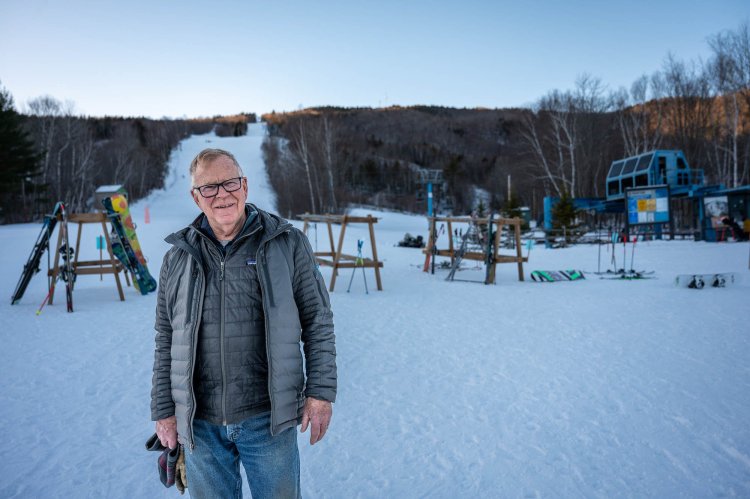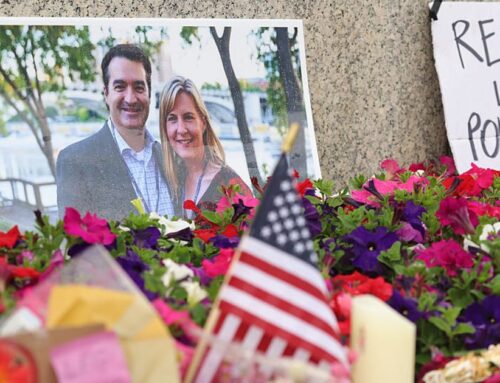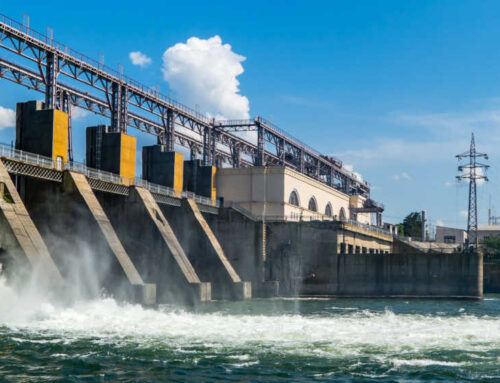Maine winter recreation faces uncertain future
January 5, 2025
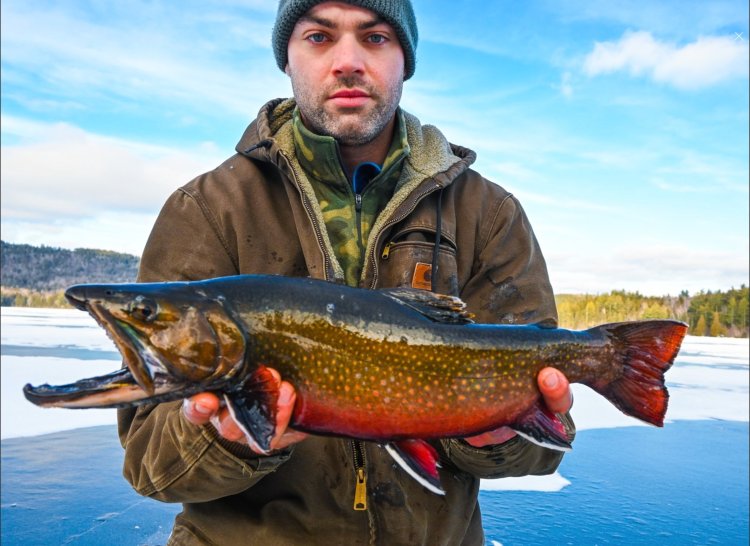
Jason Latham of Rangeley holds a fish he caught in February 2024 at a secret fishing hole in Northern Maine. Submitted photo
RANGELEY — Growing up in New Hampshire, Jason Latham said he always heard the elders in his family talking about how much more snow and ice thickness there was when they were younger.
Now living in Rangeley, his wife’s hometown, and raising their children, that theme is carried through in the stories he tells his children about what winter was like when he was growing up.
He tells them stories about hauling ice shacks and driving large trucks out on the ice that used to freeze several feet deep — something they have not experienced much growing up with warmer Maine winters in recent years, he said.
“The next generation coming up now already has enough distractions with advances in technology,” he said. “So it’s like what are you going to do all winter? And it’s just like this roller coaster: You get a bunch of snow, and then it rains, and then it melts, and it’s like you don’t have any reliable snow to do all these fun activities you did as a kid.
“So, it’s just kind of, the future’s uncertain for them. It’s going to be a totally different experience growing up than the generation before.”
When he was a kid he always enjoyed ice fishing and snowmobiling in areas such as Lake Winnipesaukee in New Hampshire and Moosehead Lake in Maine, he said. He has noticed a change in the weather and climate in those areas over the course of his more than 30 years of life.
“I tell my nieces and nephews stories about driving trucks on the ice, hauling ice shacks out there and staying overnight,” he said.
“The ice was 3 feet-plus thick and they always used to drive loaders out on Winnipesaukee to clear the rinks for the annual hockey tournament. They (children) look at you like you’re crazy because they’ve never experienced that. They don’t think it’s a good idea because pretty much their entire lives they’ve just seen open water until mid-January.”
Last year, some lakes in Maine experienced their earliest recorded ice-out and with average daily temperatures increasing in the winter, it is reducing the amount of time between lakes’ freeze-up and ice-out. This also cuts into the length of time people have to enjoy ice fishing and other winter lake recreation.
Lake Auburn saw its ice-out March 13 last year, the earliest in recorded history. Sabattus Pond also saw a very early ice-out last year on March 6. Mooselookmeguntic Lake and Rangeley Lake in northern Franklin County saw slightly early ice-outs last year.
Maine has lost about two weeks of winter temperatures and snow cover since the early 20th century, according to information on the University of Maine website. Over the past century, the state’s mean annual temperature has increased by about 3 degrees Fahrenheit.
The state could see an overall warmup of 2 to 4 degrees Fahrenheit by 2050 and as much as 10 degrees by the end of the century due to climate change, according to UMaine’s website. How much temperatures will actually increase is highly dependent on how much greenhouse gas emissions continue to be released worldwide.
The average temperature for each December from 2019-23 and the high temperatures and low temperatures were above the normal for that month, according to National Weather Service data. Last month, temperatures were slightly below normal for December.
Last month, the average high temperature was 34.6 degrees Fahrenheit, slightly colder than the normal high of 35.2 degrees Fahrenheit, according to National Weather Service data. The average low temperature last month was 20.7 degrees Fahrenheit, which was also colder than the normal low of 21.1 degrees Fahrenheit.
The average high for December 2023 was 38.5 degrees Fahrenheit, several degrees warmer than the normal high of 35.2 degrees Fahrenheit, according to Weather Service data. The average low for that month was 27 degrees Fahrenheit, which is also several degrees warmer than the average of 21.1 degrees Fahrenheit.
The average statewide temperature for December in 2023 was 28.9 degrees Fahrenheit, several degrees higher than the mean of 18.7 degrees Fahrenheit based on data going back to 1901, according to National Oceanic and Atmospheric Administration figures.
December temperatures have been warmer than that mean going back to 2017, which had a monthly average of 16.4 degrees Fahrenheit and it was the most recent year to dip below that mean.
Dancing for snow
The warmer winters have had a starker effect on snowmobilers in the past few years around the Lewiston/Auburn area. Snow is usually accompanied by rain or warm temperatures soon after melting most, if not all, of the freshly fallen snow, according to Riverside Trail Riders Treasurer Nathan Brissette.
He likes riding on trails with about 2 feet of snowpack and an inch or 2 of soft snow on the top, but he has had to travel farther north to snowmobile in those conditions, he said. He remembers some warm winters growing up in Lisbon but has noticed that becoming more frequent in the past few years.
“Looking back, I want to say, I remember always having snow during the winter, I mean, I can remember some warm-ups and stuff like that as a child but it wasn’t like today, where you get snow and then it rains 2 or 3 inches a couple days later and it’s 55 degrees,” he said. “That seems to happen way more frequently than I can remember as a child.”
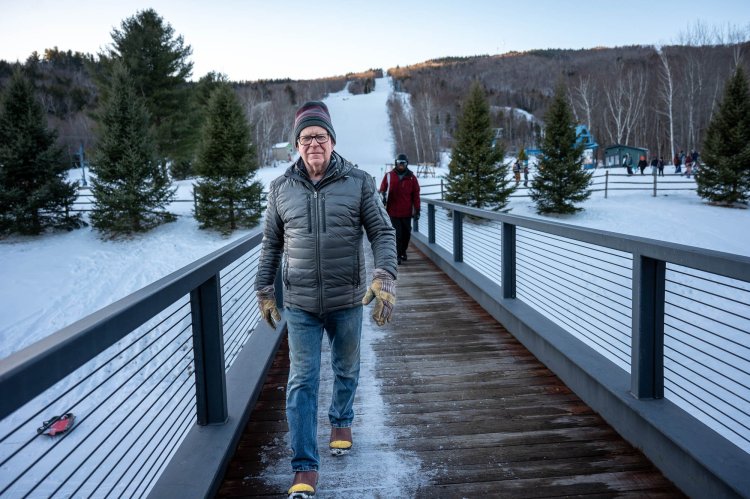
Roger Arsenault, walking Dec. 26 at the base of Black Mountain in Rumford, says there has been a gradual increase in warm weather in the area over his lifetime. Andree Kehn/Sun Journal
It has been five or six years since he has seen a winter with good snowfall, he said. In recent years, Lisbon trails have only had enough good snowpack for about two weeks of snowmobiling. Last month followed the same melting pattern as the past few years, leaving little snow on the ground in central Maine for much of the month.
Though the temperatures last month were slightly below the normal high and low temperatures in Gray, the National Weather Service observed far less snow last month than normal, with the normal at 17.7 inches. Last month the observed snowfall was 8.8 inches.
Snowfall for December has been below the normal recorded in Gray going back to 2020, the most recent year when the average for the month exceeded the normal with 18.8 inches, according to National Weather Service data.
Snowmobile clubs rely on natural snow and when temperatures are warmer they must close trails, Brissette said.
The more frequent winter rain has caused washout problems along trails, requiring more time and effort to clean up trails in the spring, which is difficult with low club membership.
As conditions around Lake Auburn have not been ideal for snowmobiling, the Perkins Ridge Sno-Travelers club has focused a lot of its efforts on grooming for other winter activities, such as snowshoeing, skiing and fat-tire biking, according to Trail Master Dan Bilodeau.
“Last four years you could barely snowmobile two weeks, so all our efforts and monies go into continued pedestrian and bike users,” he said.
If trails become icy, groomers will often pull snow from the side of the trail to create some snowpack, he said.
Every year club members do a “snow dance” and hope for snow and when none comes all they can do is “more snow dancing,” he said.
Making snow
Roger Arsenault grew up in Maine and has lived most of his life in the state. He started skiing at age 3 and participated in other winter sports while growing up in Rumford. He started skiing at Black Mountain in the 1960s, in a region that has a legacy of producing nationally and internationally competitive skiers and hosts national ski competitions.
“It was the thing to do in the wintertime and skating but mostly skiing,” he said. “My career was skiing. So I’m oblivious to whatever — you know, the basketball and the other sports. But we had just a slew of kids. Everybody skied. And we had — over the years — have had Olympians that came out of our town. And then my generation grew up and my kids got into it, and the cycle started over again.”
Arsenault, the chairperson of the Black Mountain of Maine board of directors, taught his kids to ski when they were growing up, an activity that often becomes a tradition in families. Youth interest in skiing ebbs and flows, he said, with more interest some years than others. But there is not as much interest in the sport now as in previous decades, he said.
The mountain has grown to be the fourth-largest ski area in the state, he said. Part of what helped it grow is its ability to make snow even as warmer winters have resulted in less natural snow.
Ski resorts can produce snow to extend the season and capture more business, Arsenault said.
Black Mountain installed its first snowmaking machine in 1991. With a $1.2 million grant, the resort will invest in improvements to its snow machines this year.
The resort is keeping snow on the ground better this year than last, he said.
Last year, a lot of rain in December washed away all the man-made snow, requiring them to start over, he said.
Conditions this year have been better: As of mid-December, the mountain had more than a foot of snow, providing a good base.
“We probably had 12-14 inches of snow,” he said. “After the warm spell we went through we probably have 6 inches of snow left on the ground, so it’s a much different situation here than it is in Lewiston-Auburn. On top of that you add snow from the snow machines to make a nice skiing pack.”
Losing a heritage?
The outlook among winter recreationalists is different depending on who you ask. Some are hopeful that winter recreation activities will continue in Maine despite warmer winters; others are less confident.
The Riverside Trail Riders snowmobile and ATV club has only a few active members, Brissette said. Even when there is snow on the trails it can be a struggle to find enough members to help groom.
He said he hopes the warmer winters Maine has experienced the past few years are just a short-term cycle and cold winters return. But sometimes he has doubts about the future viability of snowmobiling locally, and if it were not for the club also being an ATV club, it might have already dissipated, he said.
“We only really have three to five active snowmobile members,” he said. “Our club is an ATV snowmobile club and the majority of our members are ATV. So, if it wasn’t for the ATV side, to be honest with you, I don’t know if we would have survived.”
Bilodeau said he is more optimistic about the future of winter recreation, hopeful that clubs will adapt as long as they have the members and funding to keep trails open and safe.
Arsenault said he does not think the situation is as stark as people think it is. Though he has noticed an overall increase in winter temperatures in Maine over his lifetime, he can also recall winters 40 or 50 years ago that were warm, he said.
“I think the climate change publicity has grown to the point where we over exaggerate the situation,” he said. “It is definitely warmer but it’s not as extreme as they say it is, it didn’t just happen yesterday.”
He does acknowledge that it will likely only get warmer and winter recreation could change for future generations.
“I’m 76 but my sons are 40. I would say, in their lifetime things are going to change, and my grandson’s generation probably,” he said. “I’m not contesting it, I think there will be some issues.”
Latham is less assured about the future of winter recreation in Maine. For him, the signs seem grim.
“When it’s gone here, where are you going to go next?” he asked. “It’s not like we ran out of real estate. I guess you could go out to the Rockies, maybe in some of the higher elevations, and Montana, Colorado, or something. But they’re in a similar boat there, too. So it’s almost like you’re witnessing this dying, these dying winter sports. It sounds pretty grim but realistically I think that’s what’s happening.”
Search
RECENT PRESS RELEASES
Related Post
